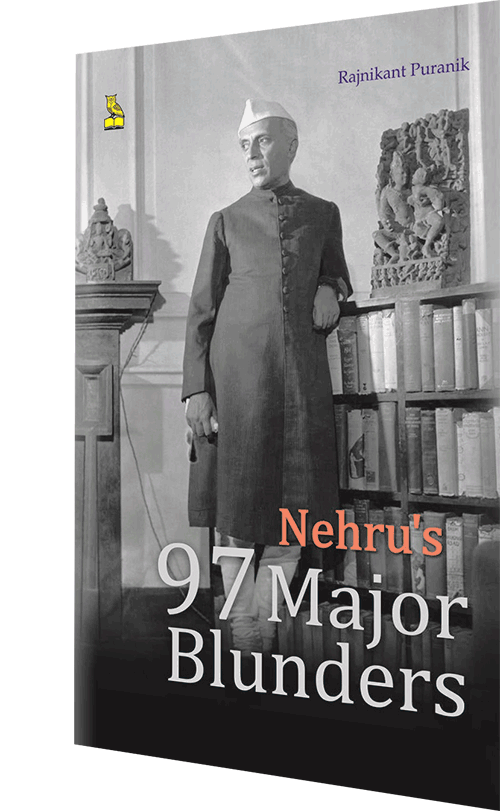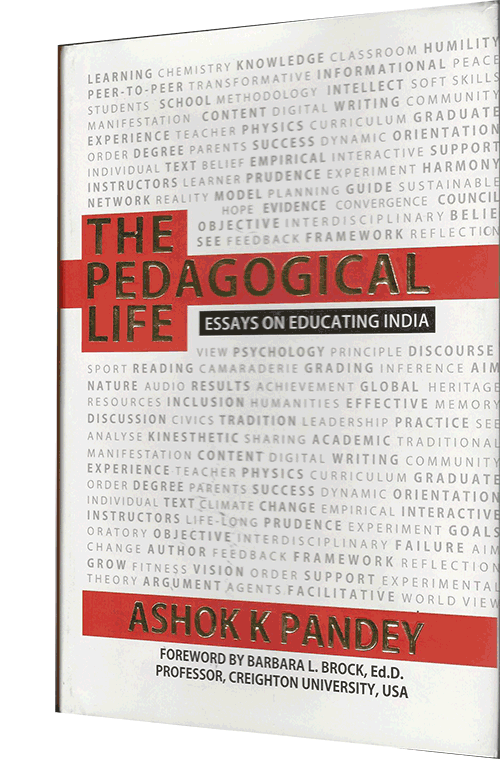Nehru’s 97 major blunders, Rajnikant Puranik, Pustak Mahal; Rs.350; Pages 222
 Although the country’s “traitorous academics” enjoying well-paid tenures without any accountability, and its subsidies-addicted middle class wrapped up in foolish dreams of the nation attaining global super- power status in the near future are in wilful denial, the plain truth is that 70 years after attaining full independence, the sovereign, socialist, secular and holier-than-thou republic of India is arguably the most illiterate, poor and inegalitarian nation on earth. Despite the trappings of democracy, open, uninterrupted and continuous social and economic injustice is the rule.
Although the country’s “traitorous academics” enjoying well-paid tenures without any accountability, and its subsidies-addicted middle class wrapped up in foolish dreams of the nation attaining global super- power status in the near future are in wilful denial, the plain truth is that 70 years after attaining full independence, the sovereign, socialist, secular and holier-than-thou republic of India is arguably the most illiterate, poor and inegalitarian nation on earth. Despite the trappings of democracy, open, uninterrupted and continuous social and economic injustice is the rule.
Rajnikant Puranik, the author of this bold, forthright and overdue audit of the life and times of Jawaharlal Nehru, president of the Congress party which led India’s freedom movement and free India’s powerful first prime minister, persuasively asserts that if a strong foundation had been built by him (Nehru), India — which had the advantages of a strong private industry, respected academy, the world’s largest rail network and proven civil and military services — would have emerged a modern, educated and prosperous nation. Indeed Puranik lays the entire blame for contemporary India’s backwardness and also-ran status on Nehru, listing and substantiating 97 ‘blunders’ which he helpfully defines as “failures, neglect, wrong policies, bad decisions, despicable and disgraceful acts, usurping undeserved posts etc,” to the country’s over-eulogised first prime minister.
The first ‘blunder’, says the author was ‘usurpation’ of the presidency of the Congress party in 1929. Actually this pre-independence blunder was of his father Motilal who was Congress president in 1928, and persuaded Mahatma Gandhi to appoint his 40-year-old son with no previous work experience of any sort, his successor. The dynastic rule and nepotism of the Nehrus — Indira, Rajiv, Sonia & Rahul — who dominated and misruled India for over half a century plunging millions of its citizens into deep poverty, illiteracy and misery — began in 1929.
In the first section of this revealing narrative, Puranik lists nine Nehruvian blunders including the alienation of Mohammed Ali Jinnah, which strengthened the latter’s resolve to carve out a separate Pakistan. But perhaps the most startling revelation is that in the Congress party presidency election of 1946 — of crucial importance since the party leader would become independent India’s first prime minister — 15 (of 18) Pradesh Congress Committees voted for Sardar Patel and three abstained. Despite not receiving a single vote, at the behest of Gandhiji, Patel withdrew his candidacy and Nehru “pregnantly silent”, assumed the presidency of the party and automatically became the newly independent country’s first prime minister with catastrophic consequences.
In the second section, the author highlights Sardar Patel’s brilliant integration of 525 pre-independence princely states — except Kashmir which Nehru insisted on handling — into the Indian Union. In this section Puranik recounts 14 Nehruvian blunders, notably the loss of half of Kashmir to Pakistan, internationalisation of the accession of Kashmir to India, needless insertion of Article 370 into the Constitution, and inept management of the Kashmir issue in the United Nations, as a result of which Kashmir to this day is a thorn in India’s side.
Although he fancied himself as an expert on foreign affairs and retained the external affairs portfolio during his long reign (1947-64), Nehru not only compounded the Kashmir problem, he also allowed the “erasure of Tibet as a nation” and in a foolish display of international grandstanding, gave up an invitation to the Security Council of the United Nations in favour of Communist China. Simultaneously, he needlessly prevaricated on negotiating a long-standing boundary dispute with China in Kashmir and in the north-east, resulting in the Sino-India border war of 1962 in which the ill-equipped Indian Army suffered a humiliating defeat, which also shattered Nehru’s loudly proclaimed non-alignment foreign policy.
Yet perhaps Nehru’s greatest drawback was his fascination with Soviet ideology which he imposed upon the Indian people and the economy as a development model. Disregarding the subcontinent’s 5,000-year history and tradition of private enterprise, Nehru decreed that the State should dominate the commanding heights of the economy, neglected agriculture and created a giant bureaucracy to suppress and entangle private industry in the web of licence-permit-quota regulations which transformed India into one of the world’s Top 10 most corrupt nations. With the country’s inefficient, capital-intensive public sector enterprises managed by corrupt, business-illiterate babus unable to generate surpluses for investment in education, health and the criminal police-justice system, life for the vast majority of citizens is nasty and brutish.
In the prologue, the author admits that Jawaharlal Nehru had many good qualities and describes him as “honest, upright, secular, knowledgeable, cultured, hard-working and a man of integrity”. However Puranik warns against the commonplace intellectual dishonesty of “offsetting poor professional performance against good personal traits or vice versa”.
This is timely advice. If seven decades after independence, India is still one of the world’s poorest, unjust and unequal countries, surely it’s time to make a dispassionate assessment of the real contribution of leaders of the past to national development.
Nehru’s 97 Major Blunders is an ugly book. The layout, typeface and indiscriminate use of bold italics is off-putting. But there’s no doubt it’s an overdue reappraisal of India’s first prime minister who is not only responsible for much of the mess in India today, but also sowed the dragon seed of dynasty which has laid the nation low.
Dilip Thakore
Valuable contribution
The Pedagogical Life Essays on Educating India, Ashok Pandey, Sheriden Book Company; Rs.395; Pages 134
 It’s rare for an incumbent school principal in India to pen down his thoughts and views on education and courageously publish them in book form. The overwhelming majority of this tribe are career academics in ivory towers who opine upon, but seldom write about the why and wherefores of the continuous slide of Indian education towards a deep abyss.
It’s rare for an incumbent school principal in India to pen down his thoughts and views on education and courageously publish them in book form. The overwhelming majority of this tribe are career academics in ivory towers who opine upon, but seldom write about the why and wherefores of the continuous slide of Indian education towards a deep abyss.
However, Ashok K. Pandey, principal of the CBSE-affiliated Ahlcon International School (AIS), Delhi, is a welcome exception. A well-qualified (Allahabad University and BITS-Pilani) and highly experienced teacher-administrator (Mayo College, Ajmer; founder-principal of DPS, Jammu; the International Indian School, Dammam, Saudi Arabia and the Amity Group), Pandey has been principal of AIS since 2003. A widely respected educationist, he is also the incumbent chairman of the National Progressive Schools Conference (NPSC, estb.1973), an association of 160 CBSE schools in India with the majority (126) sited in Delhi NCR (national capital region).
Pandey’s debut book The Pedagogical Life: Essays on Educating India derives its content from three decades of rich teaching and administrative experience. In this slim volume, he airs his views on the purpose of education, the need to introduce values education into school curriculums, the role of teachers in shaping good citizens and ways and means to deliver balanced, holistic education to school children. Written in an engaging, conversational tone, the book is divided into four broad chapters — ‘Valuing Education’, ‘Teacher Preparedness’, ‘Conversation with Children’ and ‘Reflections’. They are further sub-divided into sub-chapters, each ending with discussion points.
For instance, in the chapter ‘Valuing Education’, the author philosophically muses on the essence, purpose and objectives of education; the importance of values education; how Indian education is slowly but surely upgrading itself to meet the changing needs of the country; the need for incorporating heritage education into school curriculums, and makes a spirited appeal to revive Lord Baden Powell’s famous Scouts and Guides movements in India’s schools.
The second chapter explores the critical issue of capacity building in K-12 education, the nation-building role of teachers, inclusive education, and a practical step-by-step plan for in-service teacher training programmes. The third chapter — ‘Conversation with Children’ — outlines suggestions to build healthy teacher-student relationships through positive student reinforcement. And ‘Reflections’, the last chapter, offers the author’s observations on a range of issues such as early childhood education, the Right to Education Act, 2009, collaborative problem solving, and role of new digital technologies in primary-secondary education.
The value of The Pedagogical Life is that it prompts reflection on critical issues, such as the role of teachers in equipping children with skills to compete in the 21st century, the need for Indian schools to adopt contemporary pedagogies and courses, and the steady sidelining of values education. Moreover drawing on experiential knowledge, Pandey offers practical advice to school teachers and principals on how to manage issues such as student discipline and introducing career counseling. For instance in the sub-chapter ‘Role of stakeholders’, he provides a roadmap for school managements to introduce “school-based comprehensive counseling”.
On the flip side, the author avoids taking a position on broader policy issues shaping Indian education. Writing on the RTE Act and its controversial s.12 (1) (c) which makes it obligatory for private non-minority schools to reserve 25 percent of seats in elementary education (classes I-VIII) for children from poor households in their neighbourhood, Pandey doesn’t take a stand. “Section 12 (1) (c) of the RTE Act recognises that education is a broad social responsibility for educating the country’s less privileged children, to foster social harmony and equality that are the foundation of democracy. While many argue that the privatization of education must be discouraged, governments appear to rely on the capacity of private schools, without explicitly acknowledging it,” he writes.
This is surprising political correctness for the chairman of NPSC which over the past four decades has gained an excellent reputation for supporting the fundamental right of private school promoters in Delhi and beyond, to establish and administer educational institutions of their choice, and to earn reasonable profits from the ‘occupation’ of education without government micro management as per the Supreme Court’s judgement in T.M.A. Pai Foundation vs. Union of India (2002).
Pandey has also missed an opportunity to set Pedagogical Life against a larger context. For example, in the chapter ‘Teacher Preparedness’, he fails to address the Achilles heel of teacher education — the abysmal quality of education delivered by the country’s 6,076 B.Ed colleges which are churning out ill-trained teachers by the thousands year on year. However to his credit in the epilogue, he does express anxiety about the monumental challenge of providing quality education to the world’s largest child and youth population of 550 million.
Though the book could have done with better editing and layout, it’s a valuable resource and starting point for educators to emerge from their ivory towers, and publicly debate and develop strategies to raise academic standards across the board and narrow the knowledge gap between schools in advanced OECD countries and their floundering counterparts in India.
Summiya Yasmeen